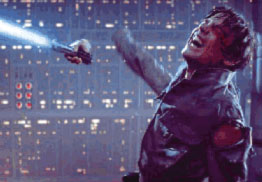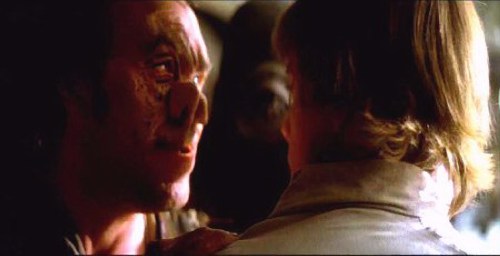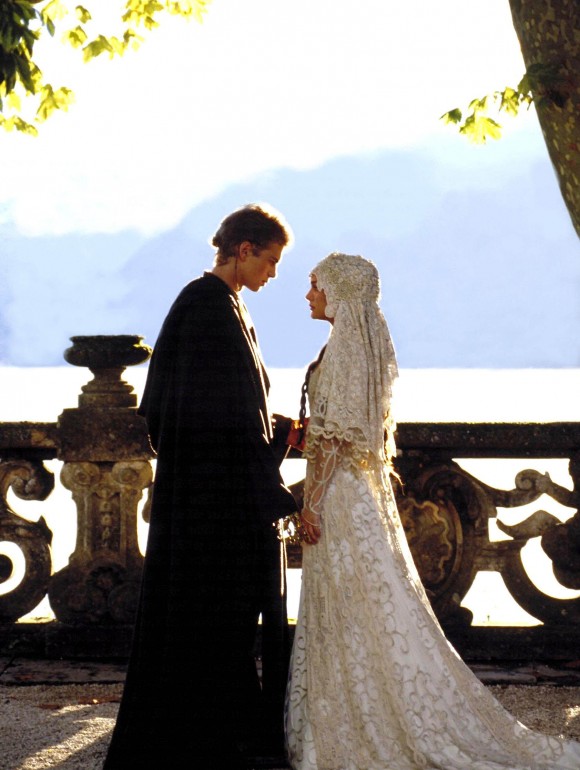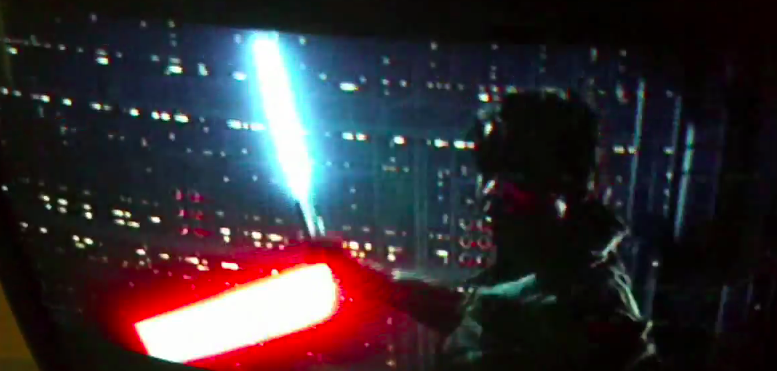aNewDomain — I used to play with swords.
What 10-year-old boy of my era didn’t watch Kung Fu movies and “The Seven Samurai” and want to be a swordsman one day? My friends and I made swords out of broomsticks or branches or whatever. We beat each other silly with them. I went so far as to spend six months creating a practice sword, crafted and varnished carefully from remnants of the family Christmas tree. I wrapped the handle in fabric.

You know, someone once asked George Lucas about the meaning of all the arm and hand amputations in the “Star Wars” universe. And he supposedly said, “That’s what happens when you play with swords.”
That’s about right.
If you fight with a shield, which I could never get the handle on, you want to keep the shield between yourself and your opponent. That’s what it’s for.
In movies you see a lot of blocking, a lot of approaching face-on then throwing the shield around to stop specific blows. That’s bullshit, though. The aim is to keep that thing between you at all times, then strike over or around it.
And when all you’ve got is a sword — or light saber — it is your shield. Always the closest thing to your opponent should be that weapon. And that means the part of your body nearest them is your hand. Amputation explained.
I can’t count the number of injuries I had to my hands over the years. The first bit of armor you want for sparring isn’t a helmet, it’s gloves. Still, is there some symbolism here? Consider:

C-3PO gets his limbs ripped off by sand people.
The guy in the bar who threatens Luke? He gets his arm cut off. And in “Empire Strikes Back,” Vader cuts off Luke Skywalker’s hand, foreshadowing Luke’s danger of falling into Darkness. As Luke tests out his new mechanical hand at the end of that movie, he’s remembering Obi Wan saying that Darth Vader is more machine than man. Which is true.
In “Return of the Jedi,” he cuts off his father’s mechanical hand, then looks at his own.
Back in “Empire,” C-3PO is completely disarticulated by blaster fire.
Anakin loses a hand to Dooku, then takes both of his – and then his head, too.
And, of course, Obi Wan cuts Anakin to pieces later in the series.
Why Do You Think They Invented The Crossguard Lightsaber?
Now all this could just have to do with the hands being closest to the action. Sure. That’s why swords have handguards. And maybe why they invented the Crossguard Lightsaber in “Star Wars Episode VII: The Force Awakens.”
(PS: Rumor has it that a new Han Solo backstory for this film was just revealed.)

Now, in psychology, we sometimes ask people to draw a person. They can draw themselves, they can draw themselves in the rain, whatever.
Then we look at the things they omit or overdo.
Someone missing feet or whose feet are crude or unusual can represent a person who feels unable to leave — or travel. Metaphorically, they might be stuck — in a feeling, a relationship, a job.
Someone who draws himself without eyes might not feel like they can reveal themselves. The windows to the soul are missing. Or perhaps they are metaphorically blind — to their own problems, feelings, the future.
Someone without a mouth might feel they cannot communicate effectively. Like their voice is lost, like they’re disenfranchised.
Hands, now, are our way of manipulating the world. In fact, that’s what the word ‘manipulate’ literally means: to use one’s hands to change something else. So if you drew yourself handless, I would worry that you felt powerless. Or that you felt you lacked agency, or the capacity to change your environment, or the ability to take control of your own circumstances.

The thug in the bar in Mos Eisley has power over Luke. He threatens, intimidates. And Obi Wan doesn’t just kill him, he takes away his power. He does that simply by lopping off his arm and hand.
Luke is freed from the power of threat, literally and figuratively, through this violent action.
As for C-3PO, the droid is ineffectual all through the “Star Wars” films — and this is reflected in the ease with which he can be disarticulated. He’s almost constantly losing or missing pieces. C-3PO has no skin. He loses his arm to the sand people. He loses everything to Storm Troopers. And he loses an eye to Salacious Crumb.
And when Vader takes Luke Skywalker’s hand, he’s taking his power: He’s taking Luke’s ability to manipulate his own destiny, as well as his ability to continue their conflict through violence. In the end, the fight isn’t won with light sabres and the assertion of power, but by becoming passive.
Luke yields power to his father, Darth Vader. Vader, in turn, chooses to use that power to destroy the Emperor.
Luke takes back his power when he takes Vader’s hand. But he doesn’t win. He uses that power, again, to become passive — to accept his fate, to choose death rather than do service to the Emperor.
Later — or earlier — Anakin loses his power to Dooku. He reclaims it almost immediately, but he makes a different choice. Rather than accept essential powerlessness as power, he continues to rail against death. To fight against fate.
He takes both of Dooku’s hands and then his head, and continues to increase in violence and power until he himself becomes a powerless slave, ultimately capable only of fulfilling the whims of Emperor Palpatine.
What Over Compensation Looks Like, “Star Wars” Style

Now, if I asked you to draw yourself and you felt powerless about things, you might draw a figure that lacks hands.
But, in feeling powerless, you might seek instead to compensate for that feeling. Sometimes we see drawings of people with exceptionally large hands, or drawings of crude stick figures whose hands are done in incredible detail or hands with too many fingers.
This is Anakin in a nutshell. Notice he doesn’t get a properly cybernetic, life-like appendage when he loses his own hand: He gets a golden hand.
Shiny, attention-getting, gaudy. In other words, he is over compensating.
And that’s Vader from start to finish. When Vader loses his other limbs — when he becomes crippled and unable to breathe without assistance — the body he then uses is not a faithful reconstruction of his bio body: It’s a grotesque giant, a huge, imposing figure that hides his ultimate physical weakness.
Even Darth Vader’s breathing is over compensatory, going from labored and shallow to that now instantly recognizable Darth Vader breathing sound, the one that announces his presence into each scene. It’s an iconic, dread-inspiring noise.
Or, like the results of any psychological inquiry, all of this might be pointless speculation.
After all, maybe losing a hand is just what happens when you play with swords.
Maybe it doesn’t mean anything more.
For aNewDomain, I’m Jason Dias.
Image one: DidYouSeeThatOne.com, All Rights Reserved; image two: NerdBastards.com, All Rights Reserved; image three: TechCrunch, All Rights Reserved; image four: EricsRandomStuff.Tumblr.com, All Rights Reserved; image five: StarWarz.com, All Rights Reserved.













